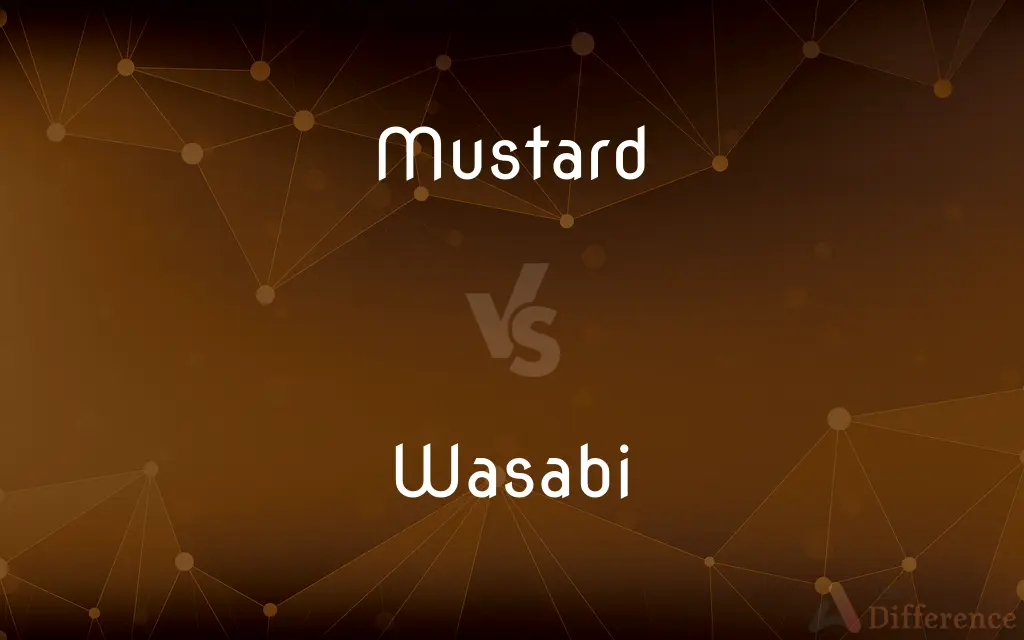Mustard vs. Wasabi — What's the Difference?
Edited by Tayyaba Rehman — By Fiza Rafique — Updated on April 18, 2024
Mustard is a condiment made from the seeds of mustard plants, offering a range of flavors from sweet to spicy; wasabi, derived from a plant root, provides a sharp, pungent heat distinctively felt in the nasal passages.

Difference Between Mustard and Wasabi
Table of Contents
ADVERTISEMENT
Key Differences
Mustard is derived from the seeds of mustard plants and is typically prepared by mixing these ground seeds with water, vinegar, lemon juice, and various seasonings, creating a paste that can range from mild to very spicy. On the other hand, wasabi is made from the grated root of the Wasabia japonica plant, known for its strong, pungent flavor that produces a distinctive burning sensation in the nasal passages rather than on the tongue.
While mustard seeds have a naturally pungent flavor, their heat diminishes when cooked, making them versatile for use in various culinary applications beyond just condiment forms, such as in sauces, marinades, and dressings. Wasabi, however, is generally used fresh and loses its potency quickly when exposed to air or heat, typically served as a paste alongside sushi and sashimi to enhance the flavors of the fish.
Mustard is commonly available and widely used across many cuisines worldwide, known for its variety in forms, including whole seed, ground powder, and prepared sauces. In contrast, wasabi is most associated with Japanese cuisine and is less commonly found in its authentic form outside Japan, often substituted with a colored horseradish mixture.
In terms of health benefits, mustard is rich in antioxidants and has anti-inflammatory properties. It is also a source of selenium, which supports thyroid function. Whereas wasabi is known for its natural antimicrobial properties and can aid in digestion and detoxification.
Mustard plants are easy to cultivate in a variety of climates and soils, making mustard relatively inexpensive and accessible globally. Wasabi, however, requires specific conditions to grow, needing a shaded, aquatic environment, which makes true wasabi rare and often more expensive than mustard.
ADVERTISEMENT
Comparison Chart
Source
Seeds of mustard plants
Root of Wasabia japonica plant
Flavor Profile
Ranges from sweet to spicy
Sharp, intense heat felt in the nose
Culinary Uses
Condiments, sauces, marinades, dressings
Commonly used in sushi and sashimi
Availability
Common and widely available
Less common, often substituted
Health Benefits
Antioxidants, anti-inflammatory, selenium
Antimicrobial, aids in digestion
Compare with Definitions
Mustard
Ground or whole mustard seeds used in cooking.
Mustard seeds were toasted for the curry.
Wasabi
Cultivation requires specific conditions.
Wasabi cultivation is challenging due to its need for shaded, aquatic environments.
Mustard
Medicinal applications.
Mustard plasters are historically used to treat chest congestion.
Wasabi
The root of the Wasabia japonica plant.
Real wasabi root is rare and prized in culinary circles.
Mustard
Condiment made from mustard seeds.
She added mustard to her sandwich for extra flavor.
Wasabi
A pungent green paste made from grated wasabi root.
He dabbed a bit of wasabi on his sushi.
Mustard
Prepared mustard sauce.
The hot dog was topped with both mustard and ketchup.
Wasabi
Known for its intense heat.
The wasabi hit her with an unexpected burst of heat.
Mustard
Symbolic or metaphorical (eg; "cut the mustard").
He really cut the mustard with that performance.
Wasabi
Condiment typically served with Japanese dishes.
Wasabi and soy sauce are essential for enjoying sashimi.
Mustard
A hot-tasting yellow or brown paste made from the crushed seeds of certain plants, typically eaten with meat or used as a cooking ingredient
Dijon mustard
Mustard sauce
Wasabi
Wasabi (Japanese: ワサビ, わさび, or 山葵, pronounced [ɰaꜜsabi]; Eutrema japonicum or Wasabia japonica) or Japanese horseradish is a plant of the family Brassicaceae, which also includes horseradish and mustard in other genera. A paste made from its ground rhizomes is used as a pungent condiment for sushi and other foods.
Mustard
The yellow-flowered Eurasian plant of the cabbage family whose seeds are used to make mustard.
Wasabi
A very pungent green Japanese condiment made from the root of the herb Wasabia japonica (syn. Eutrema wasabi) of the mustard family.
Mustard
A brownish yellow colour
A mustard sweater
Wasabi
A similarly pungent condiment made from a mixture of horseradish, mustard, green food coloring, and other ingredients.
Mustard
Any of various Eurasian plants of the mustard family, especially white mustard, Indian mustard, and black mustard, which are cultivated for their pungent seeds and edible leaves.
Wasabi
A pungent green Japanese condiment made from the plant Eutrema japonicum (syn. Wasabia japonica).
Mustard
A condiment made from the powdered seeds of certain of these plants.
Wasabi
An imitation of this condiment made from horseradish with green dye.
Mustard
A member of the mustard family.
Mustard
A dark yellow to light olive brown.
Mustard
Any of a group of toxic organic compounds that include mustard gas and the nitrogen mustards.
Mustard
A plant of certain species of the genus Brassica, or of related genera (especially Sinapis alba, in the family Brassicaceae, with yellow flowers, and linear seed pods).
Mustard
Powder or paste made from seeds of the mustard plant, and used as a condiment or a spice.
When the waitress brought the food, I asked whether she had any Dijon mustard.
Mustard
The leaves of the mustard plant, used as a salad.
Mustard and cress sandwiches.
Mustard
Dark yellow colour, the colour of mustard.
Mustard
One of a family of vesicants containing one or more 2-chloroethyl (C2H4Cl) groups, commonly used in chemical warfare and cancer chemotherapy.
Mustard
The tomalley of a crab, which resembles the condiment.
Mustard
Of a dark yellow colour.
Mustard
The name of several cruciferous plants of the genus Brassica (formerly Sinapis), as white mustard (Brassica alba), black mustard (Brassica Nigra), wild mustard or charlock (Brassica Sinapistrum).
Mustard
A powder or a paste made from the seeds of black or white mustard, used as a condiment and a rubefacient. Taken internally it is stimulant and diuretic, and in large doses is emetic.
Mustard
Any of several cruciferous plants of the genus Brassica
Mustard
Pungent powder or paste prepared from ground mustard seeds
Mustard
Leaves eaten as cooked greens
Common Curiosities
What is mustard made from?
Mustard is made from the seeds of mustard plants, mixed with liquids like water or vinegar.
Can mustard be used in cooking?
Yes, mustard seeds and powders are used in various dishes beyond just a condiment.
How is wasabi made?
Wasabi is prepared by grating the root of the Wasabia japonica plant.
Why does wasabi feel hot in the nose?
Wasabi releases vapors that stimulate the nasal passages more than the tongue.
Is mustard available in different forms?
Yes, mustard can be found as whole seeds, ground powder, or prepared condiments.
What are the health benefits of mustard?
Mustard contains antioxidants and is known for its anti-inflammatory properties.
Is wasabi always made from real wasabi plant?
Outside Japan, wasabi is often substituted with horseradish and green dye due to the rarity of the wasabi plant.
How does wasabi compare to other spicy foods?
Unlike chili pepper heat, which is sensed on the tongue, wasabi's heat primarily affects the nasal passages.
How should wasabi be stored to maintain its potency?
Wasabi should be used fresh and kept air-tight if stored to preserve its strength.
What are the health benefits of wasabi?
Wasabi offers antimicrobial benefits and can aid in digestion.
Where is mustard commonly used?
Mustard is used globally in various cuisines, from American to Indian.
Why is real wasabi so expensive?
True wasabi requires specific growing conditions and is difficult to cultivate, making it rare and expensive.
Where is wasabi primarily used?
Wasabi is primarily used in Japanese cuisine, especially with sushi and sashimi.
What is the flavor profile of mustard?
Mustard flavor can range from mild and sweet to spicy and pungent.
Can both mustard and wasabi be used as condiments?
Yes, both are used as condiments, although in different cuisines and dishes.
Share Your Discovery

Previous Comparison
Libretto vs. Opera
Next Comparison
Uncategorised vs. UncategorizedAuthor Spotlight
Written by
Fiza RafiqueFiza Rafique is a skilled content writer at AskDifference.com, where she meticulously refines and enhances written pieces. Drawing from her vast editorial expertise, Fiza ensures clarity, accuracy, and precision in every article. Passionate about language, she continually seeks to elevate the quality of content for readers worldwide.
Edited by
Tayyaba RehmanTayyaba Rehman is a distinguished writer, currently serving as a primary contributor to askdifference.com. As a researcher in semantics and etymology, Tayyaba's passion for the complexity of languages and their distinctions has found a perfect home on the platform. Tayyaba delves into the intricacies of language, distinguishing between commonly confused words and phrases, thereby providing clarity for readers worldwide.
















































